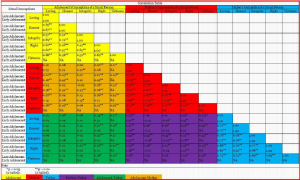Ryan James Funk and Dr. Sam Hardy, Psychology Department
When I began working with Dr. Sam Hardy, I started in a simple data entry position. I would spend ten hours a week entering responses to survey questions into a computer program. As I spent more and more time in Sam’s lab doing data entry, I began to have more and more questions about the research. “What is this measure for?” I wondered and “How does it help us investigate adolescent moral development?” In weekly meetings with Sam’s lab, I had a chance to ask these questions and Sam answered them by involving me more and more in the research. This is what ultimately led to my involvement on the present study.
Sam, my mentor, specializes in adolescent moral development. Within that domain of psychology there are different theories and camps which assert that different factors are more or less the culprit behind adolescent moral development. The present study is a smaller piece of Sam’s larger project which investigates those factors. More specifically, the present study investigates the congruence between parents and adolescents on what they believe it means to be a moral person.
We began by giving a survey to 272 early adolescents and 240 late adolescents. This survey contained a list of character traits. These adolescents, drawn from Utah schools, then rated how well they thought each character trait described a moral person. This procedure gave us a naturalistic representation of adolescent moral conceptions. This process was then repeated with the adolescents parents, giving us both the adolescent’s and parents’ report of moral conceptions. In other words, we now have data on what it means to be a moral person for both adolescents’ and their parents.
It took some time to enter all this data into the computer and to reconcile differences and inconsistencies in the data. While working with Sam, I think I learned more about SPSS (a statistical computer program) and applied statistics than I ever learned in my psychology classes on the subject. It was a sharp learning curve. In my lab meetings, Sam would assign me to run some statistic on items in the dataset or write and run computer syntax to perform some function. I would write notes furiously and pray I could remember how to do it on my own. I learned a great deal about research—the good and the bad. Sometimes things don’t go as you hoped, but other times you find things you never expected, and that makes it all worthwhile.
As I continued working on the project, I focused my efforts on the parenting aspects of the project. We had many measures and many variables in a massive dataset. In order to reduce the data to something more workable, we sorted the character traits into clusters. Some of the character traits were things like honest, faithful, kind, true, has self-respect etc. We found that several of the character traits grouped together, that is to say, they were related. We were able to group these into four clusters for early adolescents and five clusters for late adolescents. With the dataset reduced to manageable clusters, I was able to calculate the correlation between parent and adolescent. Take for instance, a teen who believes the cluster of traits pertaining to honesty is highly descriptive of a moral person. If there is a strong correlation between parent and adolescent, then statistically speaking, the parent would also believe the honest cluster is highly descriptive of a moral person. A correlation table is provided below. This table shows the within-groups and between groups correlations for mother, father, and adolescent. The primary colors indicate the within groups correlations for mother, fathers, and adolescents on the moral conceptions clusters. Because early adolescents had four clusters and late adolescents had five, there are no correlations for early adolescents on the fifth cluster.

After running all the data we had some results that were expected and some that were a bit surprising. For instance some expected findings were, (1) all within-groups correlations were significant at the p
So what does all this mean? Well, simply put, adolescents are, morally speaking, more like their mothers than their fathers. Adolescents will, over time, become more and more like their parents. Mothers view lovingness and integrity as inversely related for early adolescents and directly related for late adolescents; meaning mothers, but not fathers, are willing to shield younger children from the truth of a situation in order to preserve a loving dynamic.
My work on this project has been a rich growing experience. I learned how to manipulate data, conduct literature reviews, and helped to shed some light on adolescent moral conceptions. More important than all this, however, was the true mentorship I received from Sam. Learning the subtle nuances inherent in academic scholarship can only be learned by experience. My ORCA grant enabled me to gain that experience and to develop a relationship with an expert in my field of choice. There were many fruits to this project. Some I will never forget. The best way to describe my experience is to call it significant. No, I am not referring to statistical or academic significance here; rather, I refer to the personally significant experience I had to be part of mentored research.
